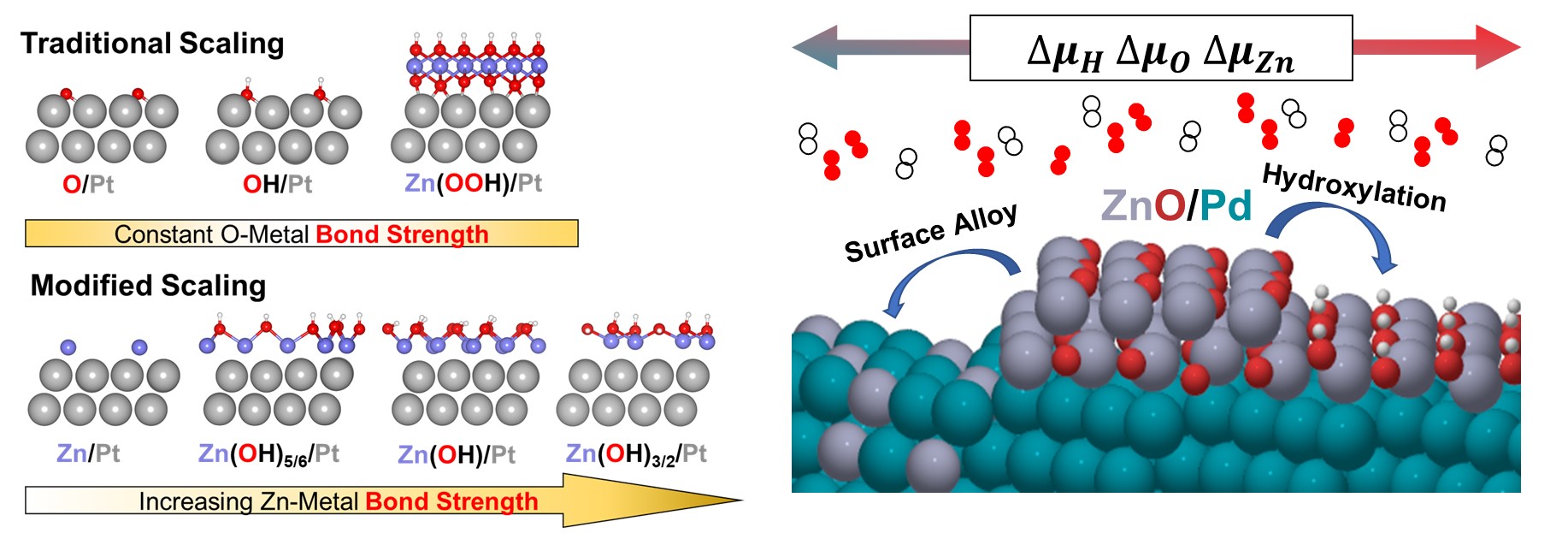(357q) Elucidating Structure-Property Relationships at Metal-Metal Oxide Interfaces for Heterogeneous Catalysis.
AIChE Annual Meeting
2022
2022 Annual Meeting
Meet the Candidates Poster Sessions
Meet the Industry Candidates Poster Session: Pharmaceutical Discovery, Development and Manufacturing Forum
Tuesday, November 15, 2022 - 1:00pm to 3:00pm
Interfaces between metals and oxides play an important role in applications ranging from catalysis to microelectronics. In heterogeneous catalysis, oxides are widely used as supports for transition metal nanoparticles. These catalytic systems have found applications in diverse areas, from energy production to abatement of the consequential pollution. The metal-metal oxide interface is highly complex and can fundamentally change the catalytic properties of the system. In the current study, periodic density functional theory (DFT) calculations, along with surface science experiments from collaborators group are carried out to systematically study the molecular-level underpinnings of the metal-metal oxide interface.
Methods: We developed a novel thermodynamic formalism that, in contrast to preexisting methods in the field, allows a more accurate comparison of DFT predicted structures and energetics with experiments where ultrathin films are grown on single crystal surfaces. The formalism allows certain species to be treated canonically, while the remaining species are represented by bulk reservoirs. Further, we developed an enumeration scheme to generate all possible non pseudomorphic and off stoichiometric ultrathin film structures on top of defined substrates. Finally, we developed a machine learning accelerated ab initio molecular dynamics scheme to study the effect of solvent at the metal-interface. The combination of these methods allowed us to perform detailed study of metal oxide encapsulated/doped metal nanoparticles and provide insights into the Strong Metal Support Interactions (SMSI) phenomena.
Strong Metal Support Interactions: Since its discovery about forty years ago, the mechanistic origins of SMSI, wherein metal nanoparticles supported on oxides are believed to be partially covered by reduced oxide films, remain elusive. Using the ZnO/Pd as a model system we proposed that the overlayers on SMSI catalysts can be bimetallic alloys or partially reduced oxides depending on gas phase conditions, coverage of oxide on the surface, and surface chemical potentials of reacting species. The methodology developed in our study is essential to make meaningful predictions of the state of the SMSI catalysts. In order to facilitate comparisons between disparate systems, we introduce new scaling relationships between oxide film formation and combination of oxide cation and anion adsorption energies. The scaling relationships held valid for a variety of oxy-hydroxy films. Moreover, they were qualitatively similar for high index surface terminations. The scaling relationships can be combined with ab initio phase diagram schemes to predict which metal surfaces are likely to promote SMSI under realistic industrial conditions.
Generalized Bonding Model: We observed that the scaling relationships of certain ultrathin oxide films don’t follow traditional bond order conservation principles. The discrepancy was attributed to changes in the oxidation states of the films’ metal cations and the bonding environment. In order to account for the changing film-substrate bonding, we introduce a more generalized bonding model. The predictive power of the model was demonstrated for ultrathin films previously studied in the literature.
Reactions at Metal-Metal Oxide Interface: We observed that the ultrathin oxide films and nanostructure oxide moieties exhibit properties completely different from their bulk counterpart. Further, certain structures like ZnOxHy and MoOxHy can alter the adsorption properties of the underlying substrates. Using DFT calculations and surface science experiments we found that Zn6H5O5 films and MoO4H moieties can change the adsorption energy of CO and OH species respectively on bare Pt(111). These changes have favorable implications for industrially relevant reactions like oxygen reduction reaction (ORR). The origin of these changes can be traced either to charge transfer or strain developed due to lattice mismatch and ultimately depends on the type of oxide. We are in the process of developing a more generalized model for these observations.
Research Interests
I am primarily interested in developing methods to study complex materials and reactions with focus on providing solutions to technical problems pertaining to sustainability. The growing advances in computational capabilities has opened the doors to high throughput data generation and analysis. However, it is still difficult to leverage these capabilities towards complex systems like metal-metal oxide interfaces due to lack of physical understanding and apparent difficulties in data generation. Therefore, there is a growing need to develop new tools which embrace the complexity of these systems.
